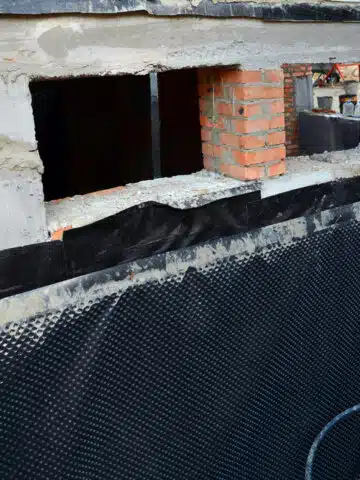Blog, Uncategorized
Choosing Between Interior And Exterior Foundation Waterproofing
In the realm of commercial construction services, ensuring a structure’s longevity and stability often boils down to foundational decisions—literally. One such critical decision is choosing the right waterproofing method. The debate on interior vs exterior foundation waterproofing is an enduring one. Both methods have their merits, but understanding the intricacies of each can help you select the most suitable option for your commercial establishment.
Understanding Interior Waterproofing
At its core, interior waterproofing focuses on managing and redirecting water that has already entered a structure’s foundation. While the term “waterproofing” suggests a complete barrier against water, the interior method operates more on the principle of water control. The goal isn’t to prevent entry but to ensure that any ingress doesn’t result in damage or compromise the building’s integrity.
Often, commercial construction services implement interior waterproofing through a combination of drains, sump pumps, and other internal water management systems. These are strategically placed to collect water that infiltrates and then channel it safely away from the building’s interior spaces. This is particularly valuable for properties where the exterior space is limited or those surrounded by other structures, making external interventions challenging.
A significant advantage of this method is its adaptability. It can be tailored to suit the specific needs of various commercial structures, addressing unique challenges presented by building designs or surrounding landscapes. Another often touted benefit is the relative ease and cost effectiveness of installation, especially when compared to extensive external methods. For establishments in densely packed urban settings or those on a tighter budget, interior waterproofing provides a viable solution for safeguarding against water related issues.
Delving into Exterior Waterproofing
Exterior foundation waterproofing takes a proactive approach. Instead of managing water once it has entered, the primary objective here is to create a barrier that prevents water ingress altogether. This method requires a more extensive process, often beginning with excavation around the structure’s foundation. Once the foundation is exposed, it’s cleaned thoroughly, and a waterproof barrier or membrane is applied. This creates a continuous shield that repels water, ensuring it doesn’t seep into the foundation.
Beyond just the membrane, commercial construction services might incorporate additional protective measures like drainage systems, such as weeping tiles. These systems work in tandem with the waterproof barrier to divert water away from the foundation, further safeguarding against potential infiltration.
The exterior method’s comprehensive nature provides a heightened sense of security. By addressing water ingress at the source, it significantly reduces the risk of moisture related issues, foundational erosion, or structural damage. While the upfront costs and efforts might be higher, the long term benefits are substantial. New commercial construction projects, in particular, tend to favor this method. Integrating exterior waterproofing during the initial construction phase allows for a smoother process and ensures that the new establishment starts on a solid, well protected foundation.
Evaluating the Cost Factor
In the debate of interior vs exterior foundation waterproofing, cost plays a significant role. Generally, interior solutions tend to be less expensive. The process is less invasive, requiring fewer materials and less labor intensive tasks like excavation. However, the potential long term benefits and robustness of the exterior method might justify its higher upfront costs for many commercial establishments.
Assessing LongTerm Maintenance
Maintenance is a crucial aspect to consider. Interior waterproofing systems, especially sump pumps, require regular checks and potential replacements over the years. Exterior waterproofing, given its preventative nature, often demands less frequent maintenance. However, any necessary repairs to the exterior system can be more involved and potentially pricier due to excavation requirements.
Weighing the Structural Implications
For commercial structures, the foundation’s integrity is paramount. Exterior waterproofing offers an added layer of protection, not just from water but also from soil gasses like radon. It also helps in preserving the foundation’s structural integrity by preventing the constant push and freeze thaw cycle that water can exert on the foundation walls. Interior methods, while effective in water management, might not offer the same level of foundational protection.
Making the Right Choice for Your Commercial Establishment
Deciding between interior and exterior waterproofing isn’t a one size fits all answer. It depends on several factors, including the building’s age, existing waterproofing measures, budget constraints, and the specific challenges posed by the site. Engaging with experts in commercial construction services can provide insights tailored to your establishment’s unique needs, ensuring that your choice not only keeps your structure dry but also stands the test of time.
While both interior and exterior foundation waterproofing methods have their places in the commercial construction landscape, understanding their differences can guide you in making a choice that aligns with your long term vision and operational requirements. As with all foundational decisions, thorough research and expert consultation are key.





